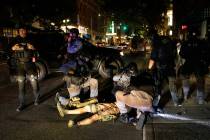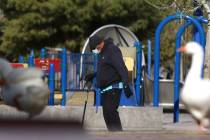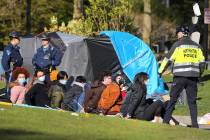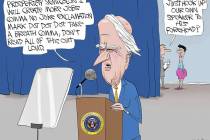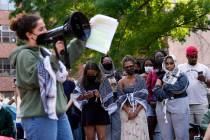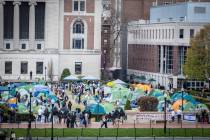Who’s paying for all these bike lanes?
In northwest Las Vegas, I motor from time to time along Lone Mountain Road between Jones and Decatur boulevards.
Recently, these streets have been repainted with solid white lines designating bicycle lanes. In addition to the re-striping, the city of Las Vegas posted reflective metal “Bike Lane” signage, 10 to the mile.
When the city marked bicycle lanes on the stretch of West Charleston Boulevard that leads out past Red Rock, that was fine by me. I have nothing against bicyclists.
But I drive the streets I’m talking about at all hours of the day and night, and there are no bicycles. Maybe an occasional teenager pedaling a few blocks (mostly sticking to the underused sidewalks, which I happen to think very wise of them, even though that’s now apparently illegal). But in effect, streets that once carried three lanes of motor vehicle traffic in each direction have now shrunk by one-third, with that space now dedicated to the use of imaginary bicyclists.
The new bike lanes aren’t up against the curb, you see. They’re set 5 feet out from the curbs, creating a strange, 5-foot-wide dead zone between curb and (imaginary) bicyclist, while placing the left handlebar of the (imaginary) bicyclist within inches of motor vehicle traffic, which often zips along these thoroughfares at 50 miles an hour.
Las Vegas city spokesman Jace Radke explains in an email “The layout of the new bike lanes on Lone Mountain eliminates the need to constantly shift the bike lanes away from the curb at exclusive right turn lanes and minimizes conflicts between right turning traffic (the biggest complaint we get from bikers) and bikes. This layout provides an auxiliary lane along the curb that can be used for parking associated with utility maintenance, landscape maintenance, bus stops or deliveries. There is no congestion on Lone Mountain during peak hours because the traffic volumes are easily handled by two travel lanes in each direction.”
The city spokesfolk could not explain whether motorists will now be ticketed if they cross the unused bike paths, referring those questions to Metro, which means they’ve put this plan into effect without even asking.
(A Metro spokesman says officers will use discretion, but “extended travel” by a motor vehicle in a bicycle lane is out.)
The cost of creating these bike lanes, by the way, is $3,500 per mile, and the city “maintains about 350 miles of bike lanes,” Mr. Radke adds. “The bike lane network has been funded by a wide variety of funding sources including federal funds and grants.”
In fact, at a time when government at all levels is pleading poverty, when the Obama administration is whining the stingy Congress won’t even give them enough money to run White House tours or keep control towers open at rural airports, Regional Transportation Commission spokesgal Angela Torres and the RTC’s bicycle guy, David Swallow, confirmed last week that the RTC is currently administering a $3.1 million federally funded contract to create dedicated bike lanes on 96 miles of additional roadways, along with another 28 miles “where you have the ‘share-the-road’ signage.”
Justifications vary. Mr. Radke at the city says the bike lanes are funded “in order to improve our communities, public safety and quality of life.” The RTC’s bicycle Web page says, “The purposes of the Plan are to create safer and more convenient facilities for bicyclists and pedestrians, reduce air pollution, and limit the negative effects of inactivity. It supports the Valley’s economy and is a sound investment.”
Meaning no private investor would invest a dime in such a scheme, since it will never return a penny.
Ms. Torres at the RTC says the bike lanes in Las Vegas and Henderson are funded by “different grants ... for air quality and congestion mitigation, it’s coming from the Federal Highway Administration.”
The money flows from the FHA through the Southern Nevada Health District to the RTC, she says. The health district is involved because bicycling “promotes an active lifestyle.”
Whatever. How does reducing a six-lane street to a four-lane street “mitigate congestion?” I asked.
“That was identified by the City of Las Vegas as a proposed improvement,” explains Mr. Swallow. “It’s not really for us to say.”
“Lone Mountain is a wide 100-foot right of way that will never need six travel lanes because it does not have an interchange at U.S. 95,” Mr. Radke explains. “Our goal is to have a network of streets with bike lanes that are no more than one mile apart. Since Craig Road (a half mile to south) and Ann Road (a mile to north) are very high traffic volume corridors and truck routes, we selected Lone Mountain” for bike lanes.
But there are no detectable bicycle commuters in this part of town.
“There are also children,” Ms. Torres reminds me. “Children use bicycles.”
Somehow picturing a tiny tyke with training wheels, 6 feet out from the curb on a street where cars move 50 miles an hour, does not reassure me. And I still want to know whether anyone did a survey to find out which streets actually have heavy bicycle traffic before deciding where to concentrate these millions of dollars.
The county says it didn’t. The city says it didn’t. The RTC hasn’t done a street-by-street survey of bicycle use, either — though they do have a number of bicycle uses: “We carry approximately 50,000 bicycles per month on our system,” says Ms. Torres.
I’m impressed. And how did they get that number? Ms. Torres explains that every time a bicyclist boards an RTC bus and attaches his or her bicycle to the bike rack on the front of the vehicle, the driver is supposed to click a clicker. Over one month, they average about 48,000 clicks, system-wide.
Wait a minute. If a bicycle commuter uses an RTC bus to cover part of his or her route to work or school every day, he or she would account for one click in the morning and one in the evening, at least 20 days per month. That means as few as 1,250 daily bicycle commuters could generate those 50,000 “clicks” a month.
Are we spending millions of dollars to create hundreds of miles of bike lanes for 1,250 people?
Urban planners holding conventions in Cambridge or Berkeley or Amsterdam or Rome may look out their hotel windows and experience ecstasies at all the gasoline being saved by all the bicyclists they see, but the kind of verbiage you will find at the RTC’s bicycle Web page verges on the ludicrous when applied to 20th-century cities built in 110-degree deserts around the automobile, which ain’t going nowhere no matter how many bankrupt electric car companies the Obama White House chooses to lavish with the last of our cash.
I believe it was Dudley Moore’s partner, Peter Cook, who predicted back in the ’60s that the British Empire would not so much fall to conquest as “sink giggling into the sea.”
We’re close.
Vin Suprynowicz, an editorial writer for the Review-Journal, is the author of “Send in the Waco Killers” and the novel “The Black Arrow.” See www.vinsuprynowicz.com.








